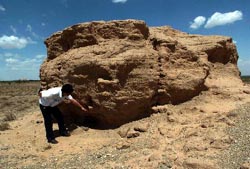
Clay mausoleums dating back to the Western Xia Dynasty
(1032-1227) in northwest China's Ningxia Hui Autonomous Region, Known as the
"Pyramids of China", are in danger of collapsing due to damages by
the elements, especially wind erosion, over the past 1,000
years.
"The largest tomb, about 15 meters high, has a two-m deep and
one m-wide crack, and a 10-m stretch of the western wall has
collapsed," said Dai Wenzhen, deputy director of the administration
office of the tombs.
Most tombs belonging to noblemen face similar problems, Xia
said, adding that partial ruin has been reported on some tombs.
"The whole group of noblemen tombs are in danger of vanishing,"
the official warned, calling for emergency measures to protect the
cultural relics.
"Protection of the tombs must be put in place at once," Xia
said.
The Western Xia Imperial Tombs comprise nine mausoleums of emperors
and 207 tombs of noblemen.
In 2000, the Chinese government allocated 10 million yuan (about
US$1.25 million) for the repair and protection of the No. 3
imperial tomb. Experts sprayed, daubed and injected chemical
materials into the tomb walls.
The experts also reinforced the bottom of No. 1, 2, 4 and 6
imperial tombs to curb the wind erosion.
As a result of these substantial, effective efforts, the
collapse of some of the imperial tombs has been slowed. But other
noblemen tombs have not received adequate protective measures owing
to the lack of financial support.
The Western Xia mausoleums, together with 13 other natural
attractions and cultural relics, have been list in the first group
of the country's heritage list.
(Xinhua News Agency June 1, 2006)

